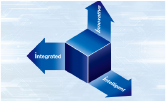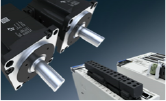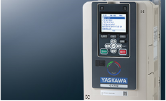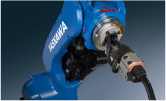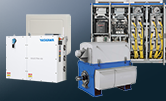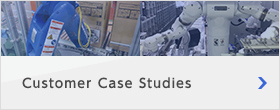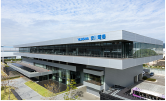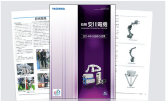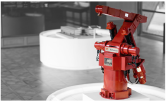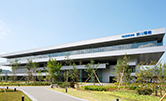| YASKAWA Electric Corporation (President: Koji Toshima) has developed a new-generation industrial robot “MOTOMAN-SDA10” which can shift work that has been performed by humans and a simple shift to robots has been difficult, such as assembly of manufacturing lines and interprocess transportation in physical distribution processes, to robots directly. The reception of orders will start on December 1, 2007. |
| |
| 1. Purpose of the commercialization |
| |
We developed a new-generation industrial robot whose form and movement is similar to humans, and started the mass production of robots which coexist with humans and support their work for the first time in the industry, and have been supplying them to the market since then. The accumulated shipping quantity is approximately 1,000 units, and our robots have been applied to the production lines centering on automobiles, electrical machinery, and physical distribution industries.
We have developed new and more advanced products by pursing product performances and eliminating losses completely while reflecting market’s feedbacks including the reduction in operating time and response to thin bodies which is highly demanded.
In future, we will make proposal including the application methods with a view to respond to various customers’ production systems to create new application fields of our robots and make them the mainstay of our business.
|
| |
|
| 2. Main features |
| (1) |
Quick operation with two-thirds of operating time |
| |
At small part assembly sites, the work efficiency is increased by placing tools and parts to assemble near the workers so that they can work within a minimum operating range and the hand’s travel distance during work is short. In this case, robots rarely reach the maximum speed and just repeat acceleration and deceleration. We reviewed the motoring mechanism at the robot joint areas, and then increased the motor output, reduced power transmission losses in the reduction gear, and optimized the gear ratio. Keeping the same level maximum speed, we have improved accelerating force at each joint axis so that the robots can reach a high speed even at a short distance. This has reduced one-third of the operating time compared to the conventional time (in comparison with YASKAWA’s conventional models in specific patterns). |
| |
|
| (2) |
Thin body with two-thirds of the shoulder width and a half of the arm cross section |
| |
To achieve a thinner form closer to human’s upper body and minimize changes in the user’s current work environments, we flatten our robots by reducing the overall length of the motoring mechanism at the robot joint areas. This reduced one-third of the shoulder width to 500 mm (in comparison with YASKAWA’s conventional models). In addition, by placing the shoulder position higher at 1,200 mm, changes in the workbench area are minimized, and the robot’s operating range is ensured in an optimum area over the workbench.
The arms are also thin with a half of the conventional cross section (in comparison with YASKAWA’s conventional models), and we have greatly reduced interferences between arms and with the equipment being assembled which occur frequently during assembly. |
| |
|
| (3) |
New teaching support software |
| |
In theory, if a robot has six joints, postures of the hands attached at the tip of the robot arms can be selected freely in 3D space, and calculational arm postures are determined unambiguously by the hand’s postures and positions. “MOTOMAN-SDA10” has seven joints like humans so that it can move the arms and change their postures similarly to humans and it has a broader operating range. With these seven joints, the arm postures can be changed freely to fix the hand postures attached at the tip of the robot arms. We simulate an optimal operating path to increase the efficiency further using a PC, and are also preparing new teaching support software to calculate arm postures and paths. |
| 3. Main applications |
| |
Assembly in the manufacturing industry (bolt tightening, parts assembly/insertion and transportation)
Transportation in physical distribution processes (interprocess/in-process transportation of various members, arrangement before process) |
| 4. Sales plan |
| |
Sales plan: 1,200 units/year for 2008, 2,400 units/year for 2009, 3,000 units/year for 2010 or after |
| |
| Information: |
This robot “MOTOMAN-SDA10” will be exhibited and demonstrated at the YASKAWA Electric Corporation booth at the “2007 International Robot Exhibition” held at the Tokyo Big Sight from November 28 to December 1, 2007.
|
| |
Attached photo ”MOTOMAN-SDA10”
|
| |
|
[Contact]
YASKAWA Electric Corporation
Robotics Division, Business planning department, Assistant Manager
Hiroyuki Ataka
Tel: + 81-093-645-7703
Fax: + 81-093-631-8140 |
|
 Region
Region



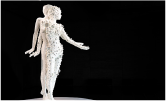 Principles & vision
Principles & vision
 Procurement
Procurement
 Sustainability for the Yaskawa Group
Sustainability for the Yaskawa Group
 Customer satisfaction
Customer satisfaction
 Supply chain
Supply chain
 Social contribution
Social contribution
 Compliance & risk management
Compliance & risk management



